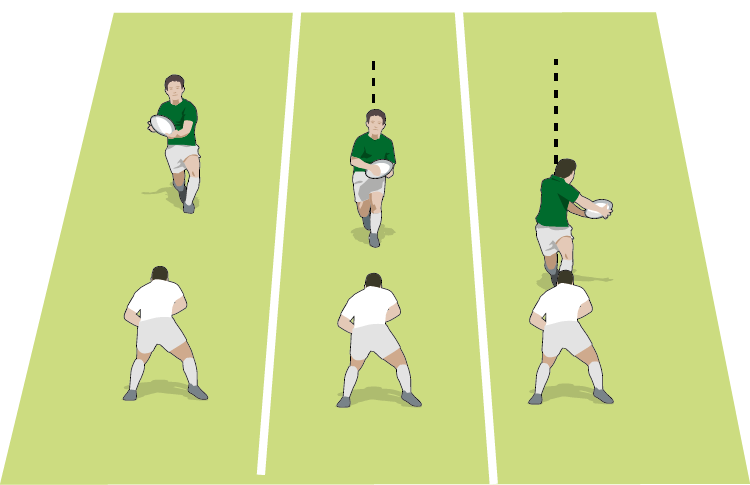Fix a defender and pass
Holding defenders to open space for receivers to move into is a key skill. Colin Ireland and Dan Cottrell present key points to help youngsters learn it.
Generally, defenders want to chase the ball carrier, but their mind is always on whether to move on to potential receivers.
As the ball carrier, your team-mates have a responsibility to fix defenders, and, if possible, move them away from a potential receiver.
At mini level, over-exaggeration of this skill will help your players.
SUCCESSFUL FIXING POINTS
- Putting the ball under one arm will certainly attract the defender, but ensure your players have the ability to quickly get it into two hands before passing.
- Run forward fast, at game speed.
- Run at the opposite side of the defender to where you are passing.
- Look at the defender, and try to make them look at you and not possible receivers.
- Pass when the defender looks set to tackle. This can be earlier, if you are really forcing the defender to follow you.
TRY THE FRENCH METHOD
In France, coaches also teach young players to fix the defender by blocking their path on to the receiver.
To do this, the ball carrier runs at the near-side shoulder of the defender and, as the defender is about to tackle, passes the ball to their receiver, legally blocking the direct path between defender and receiver.
TRAINING TIPS
- Practise passing both left and right.
- Only perform 2v1 once in each attempt. It helps players focus on the skill and not a secondary outcome.
EXAGGERATED MOVEMENT PRACTICE

The ball carrier pulls the defender into one of the outside channels, before passing to their support player. At mini level, it is good practice to overdo the fixing concept, so that the players really get a feel for what they are doing.
-
The attacker runs up the channel and then steps out
-
The defender must follow the ball carrier
-
The attacker then passes to the receiver who is sprinting onto the ball
MAKE SURE THAT PASSING IS A SIDEWAYS ACTIVITY

-
Carry the ball in two hands
-
The defender must follow the ball carrier
-
The attacker then passes to a receiver sprinting onto the ball
The first principle of rugby is to go forward. If you can’t go forward, you pass the ball to someone who can.
So, from your going forward position, facing up the field, you pass the ball across your body to a team-mate. Rarely do you turn to face them and pass it from the belly button outwards.
Further to that, to fix a defender, you need to be facing forwards, otherwise the defender can easily drift from the passer to the receiver.
To improve your players’ passing, you have to work on both handling skills – that’s catching and passing in different directions – and sideways passing skills.
The most common way is to run lines of three or four players up and down a box, passing as they do so.
Though it is not the most exciting exercise, it can form part of a warm-up routine, and at least ensures some habit forming.
It is best to run the exercise over a short distance, concentrating mostly on the middle player or players.
In a two minute burst of activity, each player should be passing ’sideways’ at least six times.
Related Files
Newsletter Sign Up
Coaches Testimonials

Gerald Kearney, Downtown Las Vegas Soccer Club

Paul Butler, Florida, USA

Rick Shields, Springboro, USA

Tony Green, Pierrefonds Titans, Quebec, Canada
Subscribe Today
Be a more effective, more successful rugby coach
In a recent survey 89% of subscribers said Rugby Coach Weekly makes them more confident, 91% said Rugby Coach Weekly makes them a more effective coach and 93% said Rugby Coach Weekly makes them more inspired.
Get Weekly Inspiration
All the latest techniques and approaches
Rugby Coach Weekly offers proven and easy to use rugby drills, coaching sessions, practice plans, small-sided games, warm-ups, training tips and advice.
We've been at the cutting edge of rugby coaching since we launched in 2005, creating resources for the grassroots youth coach, following best practice from around the world and insights from the professional game.












